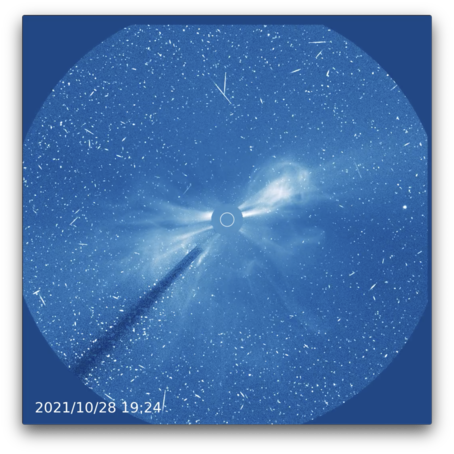The Sun Awakens!
For fans of explosive solar activity, the past few years have been rather a disappointment as the Sun has endured the inactive portion of its 11-year solar cycle, known as "solar minimum".
But over recent months, we have seen signs that the Sun is again waking from its slumber, with increasing numbers of sunspots on the Sun's visible surface, and fizzling active regions in its extreme-ultraviolet atmosphere.
This slow-and-steady rise towards the next solar cycle maximum was highlighted spectacularly this week with a number of powerful solar flares, topped by a massive X1-class solar flare on October 28th, and a series of associated coronal mass ejections(CMEs) hurling clouds of plasma in Earth's direction.
Images of these spectacular events were captured by SOHO's LASCO C2 and C3 coronagraph telescopes, which provide us with direct imaging of the extended solar atmosphere and near-Sun region of space.
In the below animation, images from both of these telescopes have been blended together by Brendan Gallagher of the US Naval Research Laboratory, to provide a stunning sequence of data spanning October 27 - November 3, 2021.
The animation shows at least a dozen separate eruptions, including the CME initiated by the October 28 CME, with that particular event followed by what is known as a "particle (proton) storm" in which energetic particles are blasted towards the spacecraft at velocities close to the speed of light!

An eight-day sequence of 'blended' LASCO C2 and C3 images showing numerous coronal mass ejections.
Credit: NASA/ESA/NRL/Brendan Gallagher.
Image:
PNG
[PNG 6.2M],
TIFF
[PNG 5.3M]
Movie:
Full-size
[MP4 99M],
Half-size
[MP4 24M]
SOHO has endured many such events in its more than 26 years of operation, and thankfully suffers no ill-effects as a consequence.
Here on Earth, one of the most spectacular (and harmless!) consequences of these Earth-directed ejections has been sightings of aurorae as far south as California!
In this instance, these aurorae were driven by a so-called "cannibal CME" that erupted on November 2nd, blasting out from the Sun at an estimated 1600 kilometers per second (nearly 3.5 million miles per hour!), sweeping up earlier released CMEs that were ahead of it, and barreling into Earth's magnetosphere less than two days later.
Aurorae are entirely harmless, but are one of the many facets of what we call "space weather" - a characterization of the conditions in space near Earth, which under certain circumstances can lead to interference with navigation and communication satellites and, in extreme circumstance, damage power grids on Earth.


